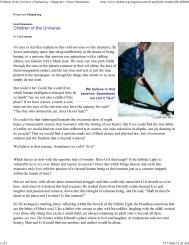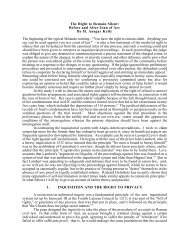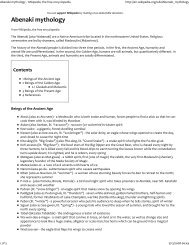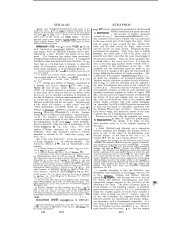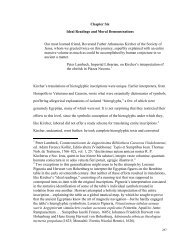Encylodaedia Biblica; a critical dictionary of the literary, political and ...
Encylodaedia Biblica; a critical dictionary of the literary, political and ...
Encylodaedia Biblica; a critical dictionary of the literary, political and ...
You also want an ePaper? Increase the reach of your titles
YUMPU automatically turns print PDFs into web optimized ePapers that Google loves.
PHCENICIA PHCI3NICIA<br />
<strong>the</strong> Book <strong>of</strong> Judges shows, <strong>the</strong> conception <strong>of</strong> 'judges '<br />
as rulers <strong>of</strong> a state, with royal but not hereditary powers,<br />
cated to his lord <strong>the</strong> god <strong>of</strong> Lebanon (13a'al-lebanon) 3s<br />
a '' first fruits " (6aapxlj) <strong>of</strong> copper ' (nun> nzwiz) in <strong>the</strong><br />
was not unfamiliar.<br />
temple upon <strong>the</strong> hill Muti Shinoas near Amathus (Ohne-<br />
Of <strong>the</strong> native histories written by <strong>the</strong> Phcenicians falsch-Richter, Kypros, 119). The Tyrian dominion In<br />
<strong>the</strong>mselves nothing has come down to us, even in Greek Cyprus must accordingly have extended thus far. These<br />
l,. Sources. trarislntiotis, except a few extracts (pre- designations show that, in <strong>the</strong> interval between Hiram I.<br />
served by Josephus), from <strong>the</strong> Chronicles <strong>and</strong> Ethhaal, <strong>the</strong> ' kings <strong>of</strong> Tyre' had become 'kings<br />
<strong>of</strong> Tyre, which Meiinnder <strong>of</strong> Ephesus had translated <strong>of</strong> <strong>the</strong> Phcenicians,' <strong>and</strong> thus had considerably extended<br />
into Greek ; <strong>the</strong>y relate to <strong>the</strong> period extending from <strong>the</strong>ir authority, in particular by acquiring <strong>the</strong> sovereignty<br />
969 to 774 B.C. (c. Ap. 118 ; Ant. viii. 53 [also viii. 31 on <strong>of</strong> Sidon. This is confirmed by <strong>the</strong> Assyrian data, that<br />
<strong>the</strong> era <strong>of</strong> Tyre]. Ant. viii. 132) <strong>and</strong> to <strong>the</strong> siege uuder <strong>the</strong> whole coast from 'Akko (near <strong>the</strong> Israelite frontier) to<br />
Elulaxs (Ant. ix. 142). Josephus also (6. A$. 121)<br />
gives <strong>the</strong> list <strong>of</strong> kings during <strong>the</strong> period from Nebuchadrezzar<br />
down to Cyrus (585-532 B.c.), but here, too, is<br />
doubtless dependent on Men<strong>and</strong>er, although a little<br />
before (c. Ap. lzo=Ant. x. 111) he refers for <strong>the</strong> siege<br />
<strong>of</strong> Tyre hy Nebuchadrezzar to <strong>the</strong> o<strong>the</strong>rwise unknown<br />
Jewish <strong>and</strong> Phcenician history <strong>of</strong> one Philostratus.<br />
In addition to <strong>the</strong>se Josephus cites(Anf. viii. 53=c. A$.117),<br />
for <strong>the</strong> eriod <strong>of</strong> Hiram I., <strong>the</strong> Phcenician history <strong>of</strong> Dim, who<br />
is close& dependent on Men<strong>and</strong>er. He also is not o<strong>the</strong>rwise<br />
known. It IS probable that Josephus took all <strong>the</strong>se fragments<br />
directly from a compilation by Alex<strong>and</strong>er Polyhistor (v. Gutschmid<br />
; cp Wachsmuth, EinL in die alfe Gesch. 403,f). These<br />
short fragments contain little that relates to <strong>the</strong> history <strong>of</strong><br />
Phcenician colonisation.<br />
We return now to <strong>the</strong> history <strong>of</strong> <strong>the</strong> mo<strong>the</strong>r country<br />
from <strong>the</strong> end <strong>of</strong> <strong>the</strong> Egyptian period onwards. The<br />
18. Period <strong>of</strong> little we know for <strong>the</strong> immediately<br />
independence, succeeding centuries relates only to<br />
Tyre. Tyre was successful not only<br />
in founding a colonial empire, but also in gaining <strong>the</strong><br />
supremacy in <strong>the</strong> mo<strong>the</strong>r country. Our accounts begin<br />
-since <strong>the</strong>y concern <strong>the</strong>mselves with merely biblical<br />
interests-with <strong>the</strong> first HIRAM (4.z ).'<br />
Of him we learn that he extended <strong>the</strong> city territory by mounds<br />
in <strong>the</strong> quarter Eurychoros (Jos. c. A$. 113), substituted new<br />
temples for old, to Melkarth <strong>and</strong> Astarte, dedicated a golden<br />
stele (CLJY) to BaHIFam&n in his temple <strong>and</strong> instituted <strong>the</strong><br />
festival <strong>of</strong> <strong>the</strong> awakening <strong>of</strong> Melkarth. He brought back to its<br />
allegiance <strong>the</strong> city <strong>of</strong> Utica which had refused to pay <strong>the</strong><br />
usual tribute. Mention has already been made <strong>of</strong> his relations<br />
with Israel, <strong>and</strong> <strong>of</strong> his Ophir voyages (see also CABUL, HIRAM).<br />
Josephus, in speaking <strong>of</strong> <strong>the</strong> successors <strong>of</strong> Hiram,<br />
gives only <strong>the</strong> duration <strong>of</strong> <strong>the</strong> life <strong>and</strong> <strong>of</strong> <strong>the</strong> reign <strong>of</strong><br />
each down to <strong>the</strong> founding <strong>of</strong> Carthage. We may<br />
be sure, however, that Men<strong>and</strong>er gave some fur<strong>the</strong>r<br />
particulars. It is, at any rate, clear from <strong>the</strong> list <strong>of</strong><br />
kings that usurpations <strong>and</strong> struggles for <strong>the</strong> succession<br />
were not unknown. Hiram's gr<strong>and</strong>son was put to<br />
death by <strong>the</strong> four sons <strong>of</strong> his foster mo<strong>the</strong>r ; <strong>of</strong> <strong>the</strong>se<br />
<strong>the</strong> eldest held <strong>the</strong> throne for twelve years. Then<br />
followed fur<strong>the</strong>r confusions, with regard to which<br />
tradition is very uncertain, until <strong>the</strong> priest <strong>of</strong> Astarte,<br />
Itoba'al. by violent means (see ETHBAAL) founded a<br />
new dynasty. Owing to his relation to Ahab, one or two<br />
facts respecting him have been preserved by Josephus.<br />
The length <strong>of</strong> his reign is unfortunately not known;<br />
Kuhl, following <strong>the</strong> tradition <strong>of</strong> Theophilus, assigns<br />
him twelve years (876-866 B.c.), but according to most<br />
MSS he reigned thirty-two years (though <strong>the</strong> length<br />
<strong>of</strong> life assigned by tradition to him <strong>and</strong> to his son makes<br />
this doubtful) from 885-854 B.C. The three years<br />
famine <strong>of</strong> <strong>the</strong> period <strong>of</strong> Ahab <strong>and</strong> Elijah (I K. 17 f.) is<br />
mentioned by Men<strong>and</strong>er as having lasted one year.<br />
Hiram I. is in <strong>the</strong> OT invariably called king <strong>of</strong> Tyre<br />
(2 S. 521 I K. 515 910); Ethbaal, on <strong>the</strong> o<strong>the</strong>r h<strong>and</strong>, is<br />
king <strong>of</strong> <strong>the</strong> Sidonians (I K. 1631). This last is also <strong>the</strong><br />
title borne on <strong>the</strong> oldest extant Phcenician inscription<br />
(CIS 15) by Hiram IL2 who is also named by <strong>the</strong><br />
Assyrians in 738 ; it is <strong>the</strong> inscription <strong>of</strong> a bronze<br />
sacrificial vessel which <strong>the</strong> ' governor ( 13~) <strong>of</strong> KarthadaSt<br />
(Citium), servant <strong>of</strong> Hiram king <strong>of</strong> <strong>the</strong> Sidonians, dedi-<br />
1 The individual items in Men<strong>and</strong>er's list <strong>of</strong> kings vary in <strong>the</strong><br />
tradition. We here follow <strong>the</strong> reconstruction <strong>of</strong> Riihl (Rhein.<br />
Mus. 18 565 #-although by no means certain at all points).<br />
In <strong>the</strong>ir original form <strong>the</strong> data seem to he quite au<strong>the</strong>ntic.<br />
2 That Hirani II., not Hiram I., is intended in <strong>the</strong> inscrip<br />
tion has been shown by von L<strong>and</strong>au, Beitr. ZUY Alterthums-<br />
Kunde des Orients, 1 (1893).<br />
near Berytus w-as in <strong>the</strong> possession <strong>of</strong> Tyre.' Of Ethbaal<br />
we are told that he pressed even far<strong>the</strong>r north; having<br />
founded <strong>the</strong> city <strong>of</strong> Botrys, to <strong>the</strong> N. <strong>of</strong> Byblos. in <strong>the</strong><br />
neighbourhood <strong>of</strong> <strong>the</strong> 'l'heouprosopon. Plainly <strong>the</strong><br />
intention, which was not, however, effected, was toreduce<br />
Ryhlos also to dependence on Tyre. Of Ethbaal we<br />
learn fur<strong>the</strong>r that he founded Auza in Libya. Under <strong>the</strong><br />
third <strong>of</strong> his successors, Pygmalion (820-774), Tinlaeus<br />
(<strong>and</strong>, following him, Men<strong>and</strong>er) placed <strong>the</strong> founding<br />
<strong>of</strong> Carthage in 814-3 ; its mythical foundress is called<br />
<strong>the</strong> sister <strong>of</strong> <strong>the</strong> king. With Pygmalion Josephus's<br />
extract from Men<strong>and</strong>er (Jos. c. Ap. 1 IS) ends.<br />
For <strong>the</strong> next century we get some information from<br />
<strong>the</strong> Assyrian data. The great westward campaigns<br />
<strong>of</strong> <strong>the</strong> Assyrians began in <strong>the</strong> begin-<br />
19. The<br />
ning <strong>of</strong> <strong>the</strong> ninth century.2 In 876<br />
suaerainty' ASur-nBsir-nal ~~<br />
invaded Svria -, <strong>and</strong> <strong>the</strong><br />
dynasts <strong>of</strong> <strong>the</strong> interior as weli as <strong>the</strong> kings <strong>of</strong> <strong>the</strong> seal<br />
coast, <strong>of</strong> Tyre, Sidon, Byblos. Maballata (sic), Maisa<br />
(unknown), Kaka (unknown), Amuri, ' Arvad in <strong>the</strong><br />
sea,' brought tribute-brazen vessels <strong>and</strong> parti-coloured<br />
<strong>and</strong> white linen garments as well as silver, gold, lead,<br />
copper, <strong>and</strong> cedar wood. Shalmaneser 11. (860-824)<br />
undertook <strong>the</strong> subjugation <strong>of</strong> Syria in a more thoroughgoing<br />
way. Only <strong>the</strong> more nor<strong>the</strong>rly, however, <strong>of</strong> <strong>the</strong><br />
Phcenician dynasts were represented in <strong>the</strong> army <strong>of</strong> <strong>the</strong><br />
allied Syrian princes which fought at Karkar in 854<br />
(see AHAB, SHALMANESER). The remaining cities<br />
preferred to submit quietly <strong>and</strong> in 842 <strong>and</strong> 839 paid<br />
tribute to Shalmaneser as <strong>the</strong>y also did later to his<br />
gr<strong>and</strong>son Hadad-nirari 111. (81 1-782) when he marched<br />
upon Syria.<br />
As yet <strong>the</strong>se expeditions led to no enduring suzerainty<br />
(see ASSYRIA, § 32). In <strong>the</strong> first half <strong>of</strong> <strong>the</strong> eighth<br />
century <strong>the</strong> movements <strong>of</strong> <strong>the</strong> Assyrians were restricted<br />
by <strong>the</strong> powerful opposition <strong>of</strong> <strong>the</strong> kings <strong>of</strong> Urartu. With<br />
Tiglath-pileser 111. began those systematic invasions<br />
which ended in <strong>the</strong> virtual subjugation <strong>of</strong> <strong>the</strong> whole<br />
Syrian territory.<br />
It is within this period that more precise information<br />
regarding Phceuicia first becomes accessible. Whilst<br />
<strong>the</strong> older Assyrian kings, as we have seen, mention<br />
(correctly or incorrectly) <strong>the</strong> names <strong>of</strong> a large number<br />
<strong>of</strong> Phcenician cities <strong>and</strong> dynasts, under Tiglath-pileser<br />
111. <strong>and</strong> Sargon <strong>the</strong>re are only three Phcenician states<br />
-Aradus, Byblos, <strong>and</strong> Tyre. The coastl<strong>and</strong> <strong>of</strong> <strong>the</strong><br />
Eleu<strong>the</strong>rus region, along with Simyra. 'Arka, <strong>and</strong><br />
Siyana, now belongs to <strong>the</strong> kingdom <strong>of</strong> Hamath (Annals<br />
<strong>of</strong> Tiglath-pileser : 3 R. 9, 3 ZI. 26 46), but is made<br />
by Tiglath-pileser into an Assyrian province. The<br />
Phoenician cities appear to have submitted without<br />
striking a blow. In 738 we find, amongst many o<strong>the</strong>r<br />
dynasts, Matanha'al <strong>of</strong> Arados, Sibittiba'al <strong>of</strong> Byblos.<br />
<strong>and</strong> Hiram 11. <strong>of</strong> Tyre paying tribute to Tiglath-pileser.<br />
Soon afterwards Tyre showed signs <strong>of</strong> a longing for<br />
independence; a heavy tribute was exacted from Metinna<br />
(Mytton-ie., MattBn) <strong>of</strong> Tyre in consequence (about<br />
1 As cities taken by him from Tyre Sennacherib (Prism<br />
Inscr. 2 388) enumerates : -Great <strong>and</strong> Little Sidon, Betzitti,<br />
Sarepta, Mahalliba, USii (pr. UsB),--i.e., Palretyrus,-Akzih.<br />
Akko. In Men<strong>and</strong>er (Jos. Anf. ix. 142 285) we must, <strong>the</strong>refore.<br />
read Irre'c~ re Tupiov PiSLv xai 'Aq rat $ Ildarm'por x d<br />
rroMa1 BMar rrdhrrc (so LV), <strong>and</strong> not with <strong>the</strong> o<strong>the</strong>r MSS<br />
'Ap=:Arka.,<br />
Various kings <strong>of</strong> Assyria set up steles by <strong>the</strong> Dog river near<br />
Beirut ; but <strong>the</strong>se are in such had - preservation that noteven <strong>the</strong>.<br />
names can now be deciphered.<br />
3753<br />
3754



